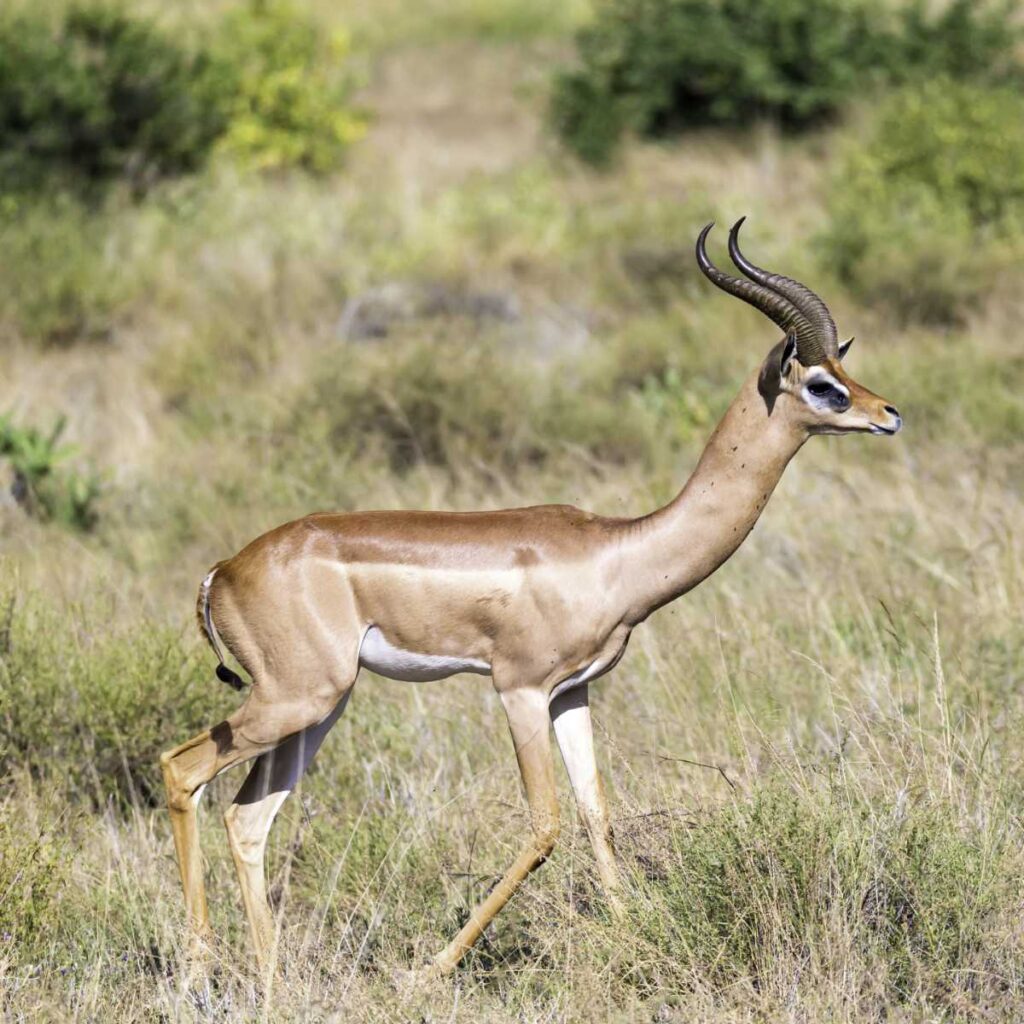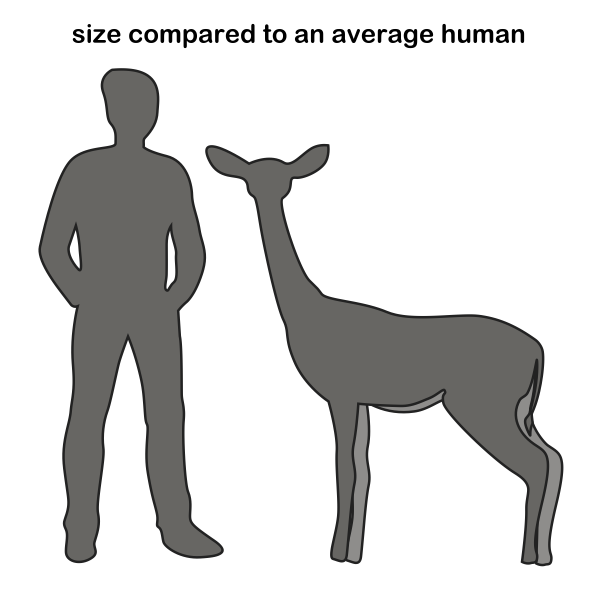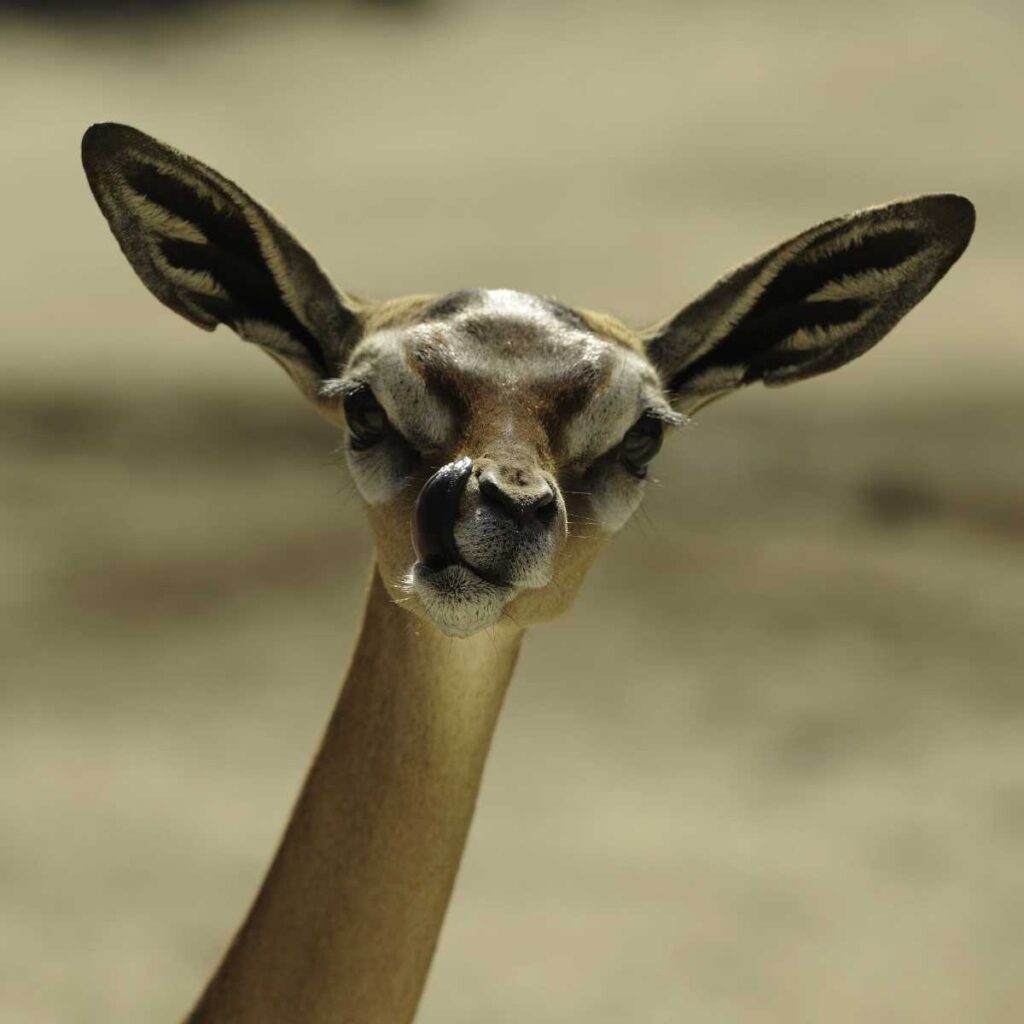Last Reviewed and Updated on March 15, 2023
Gerenuk is a unique species of antelope that inhabits the dry, bushy areas of East Africa. Famous for their elongated necks, these antelopes are easy to recognize. Explore some interesting facts about gerenuk, including their behavior, habitat, and physical characteristics.

Gerenuk (Litocranius walleri), also known as giraffe gazelle, is a species of antelope that is native to parts of East Africa. They belong to the genus Litocranius.
Gerenuks are small to medium-sized antelopes, reaching about 2 feet 7 inches to 3 feet 5 inches / 80 to 105 centimeters. An adult can weigh between 40 and 115 pounds/ 18 to 52 kilograms. These antelopes have a distinctive appearance, with long, slender necks that allow them to reach high branches to feed. They also have long and slender legs, allowing them to move quickly. Their coat is reddish-brown and is lighter on the underbelly.
They are browsing herbivores who primarily feed on leaves, shoots, and flowers from a variety of plants, especially acacia.
Gerenuk has many predators. Some of them include lions, hyenas, leopards, wild dogs…
Gerenuk breeds throughout the year. Females give birth to a single calf after a gestation period of around 7 months. The calf is able to stand and walk within a few hours of birth and is weaned at around 6 months of age.
Gerenuk is currently listed as a species of “Vulnerable” by the International Union for Conservation of Nature (IUCN).
Gerenuk (Litocranius walleri)
Size: about 2 feet 7 inches to 3 feet 5 inches / 80 to 105 centimeters
Weight: 40 and 115 pounds/ 18 to 52 kilograms
Color: a reddish-brown coat that is lighter on the underbelly
Diet: browsing herbivore
Lifespan: about 10 years in the wild, 15 in captivity
Habitat: dry bushy areas

Interesting Facts About Gerenuk
Explore some of the most fun facts about gerenuk, from their bipedality to their love of rain.

Love learning about animals? Check out our list of random animal facts. Love animal oddballs? You have to check our list of the strangest-looking animals.
1. Gerenuk has the longest neck of all antelopes
Gerenuk has the longest neck of all animals in the antelope family (antelopes, gazelles, wildebeests, hartebeests, bonteboks…).
2. They often stand on their hind legs to reach high branches
Not only do they utilize their long necks to reach leaves high above the ground, but they will also stand on their hind legs to reach leaves that are even higher. They are very stable on their hind legs.

3. Gerenuk doesn’t drink water regularly
These animals are well adapted to life in the desert. They get all of their water requirements from the food they eat, so in normal circumstances don’t really need to drink water from water sources.
4. Their name is Somali in origin, meaning “giraffe-like neck” (giraffe)
The common name gerenuk is derived from the Somali word for this animal, gáránúug. This word means something along the lines of “giraffe-like neck” or “giraffe-necked.” The Somali word for a giraffe is geri.
5. Only the male gerenuk has horns
Gerenuk displays sexual dimorphism, meaning there are notable visual differences between males and females. The most noticeable difference is the horns, which are only present in males. The horns are lyre-shaped, curving backward and then slightly forward. They measure about 10 to 17.5 in / 25 to 44 cm.
Males are also taller and heavier on average than females.
6. Gerenuk are diurnal, with a little break in mid-day
These antelopes are active during the day but do take a break during the noon. They will stand or rest in the shade.
7. They rarely fight and don’t really travel
Gerenuk rarely travels outside of its home range or territory, and fights between male gerenuk are uncommon, even though their home ranges commonly overlap. This might be one of the strategies to conserve energy and dedicate it all to foraging instead.
8. Gerenuk produce a tar-like substance from their glands
The secretion from the preorbital glands is dark, sticky, and pungent that is used by gerenuk for marking their home range or communicating with other members of their species. They aren’t the only animal that produces such substances; dik-diks, as well as some other antelopes, produce similar secretions.
9. They like rain
When it rains, the gerenuk may expose themselves to the rain instead of seeking shelter. This is thought to be a way for them to cool their bodies.
10. They live in same-sex herds with two to six members
Gerenuk forms small herds that usually consist of two to six animals. The herds are divided by sex as far as adult animals go, as female herds also have juvenile males. Males may also be solitary.
